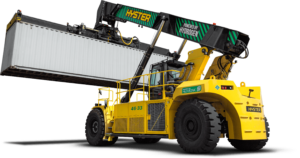
- The hydrogen powered ReachStacker has now arrived at the Port of Valencia
- The hydrogen ReachStacker is the world’s first hydrogen powered ReachStacker and has been developed by Hyster
- The Port of Valencia is a pioneer in Europe in the use of hydrogen based technology in the operation of port terminals
- With this new port machinery, Valenciaport reaffirms its European leadership in decarbonisation and in the use of hydrogen as an alternative energy to fossil fuels.
- For Joan Calabuig, president of the Port Authority of Valencia (APV), the arrival of this new machine “is a success for the Valenciaport Foundation, the Port Authority of Valencia and all the companies and institutions collaborating in the H2PORTS project, which we celebrate with the entire port community of Valencia”
Valencia, 30.08.23. The Port of Valencia has taken delivery of the hydrogen-powered ReachStacker, developed within the framework of the European H2PORTS project.
This prototype joins the hydrogen-powered tractor unit and the mobile hydrogen supply station (HRS) which will be tested in real operating conditions in the Port of Valencia from this month until December 2024.
The hydrogen ReachStacker is the world’s first hydrogen powered ReachStacker and has been developed by Hyster, a leading forklift truck manufacturer with over 90 years of experience. The machine, which arrived disassembled and transported on three trucks, will be assembled next week and will receive its first hydrogen charge
The refuelling and operational tests will be supervised by the technical team of Hyster, MSC Terminal Valencia, Centro Nacional del Hidrógeno, Carburos Metálicos and the Valenciaport Foundation as coordinator of this project.
The fuel cell powered Hyster ReachStacker is expected to offer comparable performance to a diesel reach stacker in terms of capacity and lift and drive speeds, helping to maintain similar productivity levels, and will feature independent traction and hydraulics with different electric motors to serve different functions. When combined with the right application and operating intensity, Hyster expects this ReachStacker to provide up to two shifts of operation before a hydrogen refuelling is required. For convenience and flexibility, the Hyster ReachStacker is designed to comply with the standard hydrogen filling station connection (SAE standard), allowing global use. The design includes four hydrogen tanks as a standard option to store hydrogen inside the ReachStacker.
Hydrogen is a clean energy carrier with the advantages of easy storage and, when used, produces no emissions other than heat and water. The hydrogen fuel cell converts H2 into electricity, resulting in zero-emission equipment that, when combined with the use of environmentally friendly hydrogen, is also carbon neutral. This technology has some advantages compared to other zero-emission technologies available, such as pure electric versions. This hydrogen version also has a good range, a short run time, a short fuel consumption and a low fuel consumption.
Valencia, the first port in Europe to incorporate hydrogen technologies to reduce the environmental impact of its operations.
It should be noted that since January, as part of the H2PORTS programme, the Port of Valencia has had a hydrogen supply station (HRS). It is the only installation capable of supplying the needs of the terminals through the mobile hydrogen generator and the fixed tank that stores this fuel.
This hydrogen supply station includes a fixed part dedicated to the reception, storage and compression of hydrogen up to delivery pressure and a mobile part that stores the compressed hydrogen and has a dispenser for refuelling the port machinery.
In April, the 4×4 truck tractor unit powered by green hydrogen was commissioned to move containers within its terminals, to which is now added this container stacker, which will be tested at the MSC terminal.
For Joan Calabuig, president of the APV, “the arrival of this new container terminal yard machine at the Port of Valencia reaffirms our European leadership in decarbonisation and the use of hydrogen as an alternative energy to fossil fuels. It is a success for the Valenciaport Foundation, the Valencia Port Authority and all the companies and institutions collaborating in the H2PORTS project, which we celebrate with the entire port community of Valencia, a community that can be proud of its competitiveness, professionalism and willingness to innovate”.
H2PORTS
The European project “H2PORTS – Implementing Fuel Cells and Hydrogen Technologies in Ports” coordinated by the Valenciaport Foundation, in close collaboration with the Port Authority of Valencia, and financed by the Clean Hydrogen Partnership programme, has as its main objective to test and validate hydrogen technologies in port machinery that allow applicable and real solutions without affecting the performance and safety of port operations and producing zero local emissions.
The H2Ports project involves a total investment of 4 million euros and involves, in addition to the Valenciaport Foundation and the Port Authority of Valencia, the National Hydrogen Centre, and the private companies MSC Terminal Valencia, Grimaldi Group, Hyster-Yale, ATENA Distretto Alta Tecnologia Energia Ambiente, Ballard Power Systems Europe, Carburos Metálicos (Air Products group) and Enagás.
Thanks to this initiative, the Port of Valencia is the first port in Europe to incorporate hydrogen technologies to reduce the environmental impact of its operations.
About the Clean Hydrogen Partnership: The Clean Hydrogen Partnership, successor to the Fuel Cells and Hydrogen Joint Undertaking (FCH Joint Undertaking), aims to strengthen and integrate the European Union’s research and innovation capacity to accelerate the development and improvement of advanced market-ready clean hydrogen applications in the energy, transport, construction and industrial end-uses sectors, while strengthening the competitiveness of the Union’s clean hydrogen value chain. The three members of the partnership are the European Commission, the fuel cell and hydrogen industries represented by Hydrogen Europe and the research community represented by Hydrogen Europe Research.

